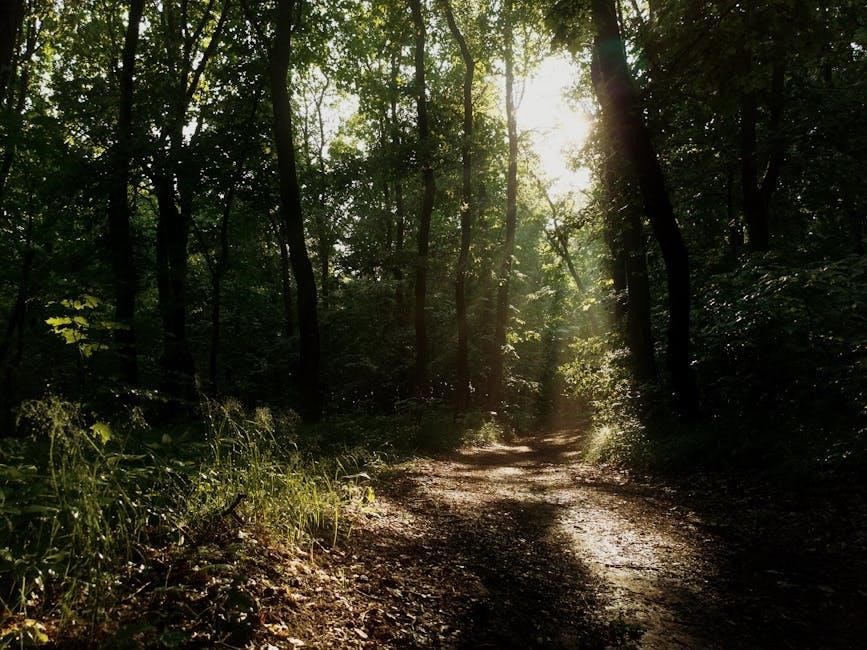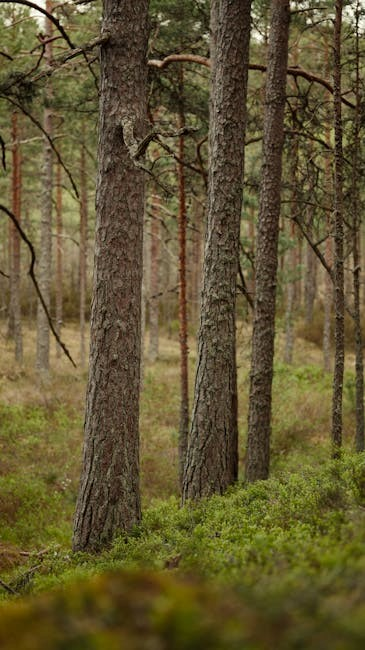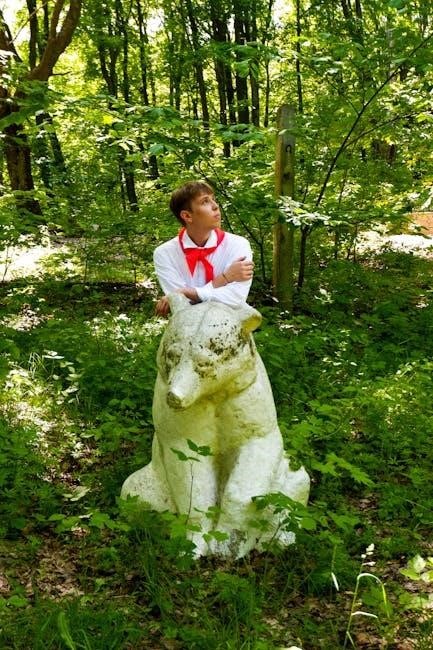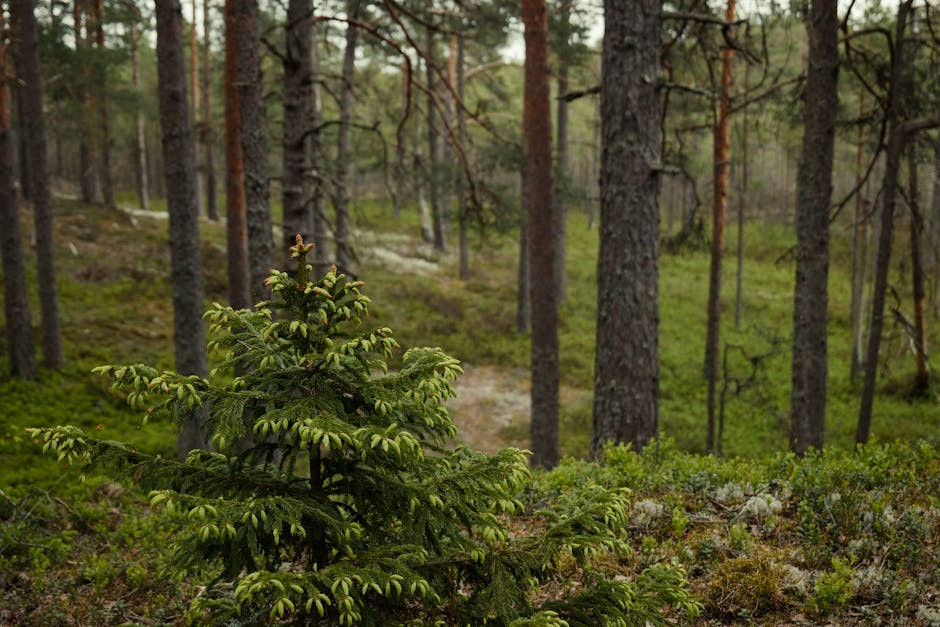Into the Woods is a captivating musical by Stephen Sondheim and James Lapine, blending Grimm fairy tales into a darkly humorous exploration of morality and wish fulfillment․ PDF scripts and librettos are widely available for educational and theatrical use, offering insights into the production’s intricate plot, characters, and iconic songs․

1․1 Overview of the Musical
Into the Woods is a musical masterpiece by Stephen Sondheim and James Lapine, weaving together classic fairy tales like Cinderella, Jack and the Beanstalk, and Little Red Riding Hood․ The story follows characters whose wishes lead them into a mysterious forest, where morality, ethics, and consequences are explored․ The musical blends humor with darker themes, offering a fresh perspective on traditional narratives․ PDF versions of the script and analysis are widely available, providing deeper insights into its intricate plot, characters, and musical elements․
1․2 Background on Stephen Sondheim and James Lapine
Stephen Sondheim, a legendary composer and lyricist, is renowned for his complex, intellectual musical styles; James Lapine, a playwright and director, is celebrated for his innovative storytelling․ Together, they crafted Into the Woods, blending fairy tales with moral complexity․ Sondheim’s musical genius and Lapine’s narrative depth created a timeless tale․ Their collaboration is detailed in various PDF scripts and analyses, offering insights into their creative process and the musical’s enduring legacy․

Plot Summary
Into the Woods intertwines classic fairy tales, following characters like Cinderella and Jack as they pursue their desires․ The woods serve as a transformative space where wishes collide with reality, leading to unexpected consequences and moral dilemmas․ The story unfolds in two acts, shifting from lighthearted adventures to darker truths, explored in detail in various PDF scripts and analyses․
2․1 Main Storyline
The story centers on a childless baker and his wife, cursed by a witch, who venture into the woods to gather magical items․ Their journey intertwines with Cinderella, Jack, and Little Red Riding Hood, each pursuing their desires․ The first act weaves together lighthearted tales of wish fulfillment, while the second act reveals darker consequences․ The woods serve as a transformative space where characters confront moral dilemmas and the true cost of their wishes, as detailed in various PDF scripts and analyses of the musical․
2․2 Key Events and Twists
The musical unfolds with the baker and his wife seeking to break a witch’s curse by gathering magical items․ A bean trade with Jack sparks a giant’s wrath, while Cinderella’s prince chases another, and Little Red Riding Hood faces a wolf․ The witch’s motivations and the consequences of wishes create dramatic twists․ The narrative shifts as characters confront moral dilemmas, and the woods’ magic turns deadly․ These pivotal moments, detailed in various PDF scripts, showcase the complexity of the story’s interconnected fates and themes․

Characters
The story features iconic fairy tale figures, including Cinderella, Jack, the Baker, his Wife, the Witch, and Little Red Riding Hood․ Each character’s journey explores themes of desire, morality, and transformation, as revealed in various PDF scripts and analyses․
3․1 Cinderella
Cinderella is a central character in Into the Woods, whose story intertwines with others in the enchanted forest․ Driven by her desire to attend the prince’s ball, she seeks magic from the Witch, showcasing her resilience and hope․ Her journey explores themes of transformation and wish fulfillment, as she navigates love, loss, and self-discovery․ PDF scripts and analyses highlight her complexity and growth, making her a relatable and enduring figure in the musical’s darkly whimsical narrative․
3․2 Jack
Jack is a pivotal character in Into the Woods, known for his loyalty to Milky White and his adventurous spirit․ His journey into the woods to sell the cow sets off a chain of events, including the magical bean trade and the giant’s wrath․ Jack’s storyline explores themes of desire, consequence, and growth, making him a dynamic figure in the musical’s interwoven narratives․
3․3 The Baker and His Wife
The Baker and his Wife are central characters driven by their desire to conceive a child, hindered by a witch’s curse․ Their journey into the woods is fueled by hope and desperation, as they seek the magical items needed to break the curse․ The Wife’s determination and the Baker’s hesitancy create a compelling dynamic, exploring themes of longing, responsibility, and the complexities of wish fulfillment․
3․4 The Witch
The Witch is a powerful, enigmatic figure who casts a curse on the Baker and his Wife, rendering them childless․ She demands a steep price for lifting the curse: a cow as white as milk, a cape as red as blood, hair as yellow as corn, and a slipper as pure as gold․ Her true motives are shrouded in mystery, and her transformation from an old crone to a youthful beauty adds depth to her character․ The Witch’s role is pivotal, as she drives the plot and explores themes of morality and consequence․
3․5 Little Red Riding Hood
Little Red Riding Hood is a naive yet brave young girl whose journey into the woods to visit her grandmother becomes a pivotal plot point․ Her encounter with the Wolf showcases her innocence and determination․ The character’s iconic red cape symbolizes her identity and serves as a key prop in the story․ Her interactions with other characters, such as the Wolf and the Baker, highlight her courage and resilience․ The musical explores her growth from a careless child to someone wiser, making her a memorable figure in the narrative․
Themes and Symbolism
Into the Woods explores themes of morality, wish fulfillment, and the consequences of desire․ The woods symbolize a transformative space where characters confront their true selves and dilemmas, blending fantasy with reality to reveal deeper truths about human nature and societal expectations․
4․1 Morality and Ethics
Into the Woods subverts traditional fairy tale morality, presenting characters with complex ethical dilemmas․ The musical challenges simplistic notions of right and wrong, as characters like Cinderella and the Baker grapple with difficult choices․ The woods, a moral limbo, force them to confront consequences of their actions, revealing that decisions often lead to unintended harm․ This nuanced exploration of morality underscores the musical’s depth, encouraging audiences to reflect on real-world ethical ambiguities and the true cost of wish fulfillment․
4․2 The Woods as a Symbol
The woods in Into the Woods serve as a symbolic space of transformation and moral ambiguity․ Representing a “green world” where traditional structures dissolve, the woods challenge characters to confront their desires and the consequences of their actions․ This liminal space, filled with mystery and danger, forces individuals to navigate chaos and redefine their understanding of right and wrong․ The woods embody the unknown, where characters must face their deepest fears and truths, ultimately emerging transformed by their journeys․
4․3 Wish Fulfillment
Wish fulfillment is a central theme in Into the Woods, as characters like Cinderella, Jack, and the Baker pursue their deepest desires․ The woods serve as a space where these wishes are both granted and complicated, often leading to unexpected consequences․ While the characters achieve their goals, they must confront the darker realities of their newfound happiness․ The musical explores the tension between desire and responsibility, highlighting that true fulfillment requires understanding the consequences of one’s wishes․ This theme underscores the complexity of human aspirations and the importance of mindful longing․
Music and Lyrics
The musical features iconic songs like Giants in the Sky and On the Path, blending whimsical and emotional melodies․ PDF scripts offer insights into Sondheim’s lyrical genius and composition․
5․1 Notable Songs
The musical Into the Woods features a range of memorable songs that captivate audiences․ Notable tracks include Giants in the Sky, showcasing Jack’s journey, and On the Path, highlighting the characters’ convergence․ Last Midnight delivers a chilling performance by the Witch, while Children Will Listen offers a poignant reflection on legacy․ These songs, available in PDF scripts, blend Sondheim’s lyrical genius with emotional depth, making them standouts in the production․
5․2 Musical Style and Composition
Stephen Sondheim’s musical style in Into the Woods is renowned for its complexity and depth․ The score blends witty, layered lyrics with intricate harmonies, creating a unique theatrical experience․ The orchestration often features a mix of classical and contemporary elements, reflecting the fairy-tale setting․ Reprises of themes, such as the titular song, tie the narrative together, while numbers like Giants in the Sky showcase the emotional range of the characters․ This masterful composition enhances the show’s dark humor and moral ambiguity, making it a timeless musical achievement․
Stage Directions and Design
The stage design for Into the Woods transforms the theater into an immersive woodland environment, with versatile sets and costumes that evoke the fairy-tale atmosphere․ Scenic and costume designers collaborate to create a visually engaging experience, ensuring the woods become a dynamic character in the story․ Specific props, like Milky White, add charm and depth to the production․
6․1 Set Design
The set design for Into the Woods crafts an enchanting and adaptable woodland environment, blending realistic and fantastical elements․ Multilevel platforms and movable structures allow seamless scene transitions, while lighting enhances the woods’ mystical aura․ The design ensures the woods feel alive, reflecting the characters’ emotional journeys․ PDF resources detail how scenic elements like Cinderella’s home and Jack’s cottage are integrated into the larger woodland backdrop, creating a cohesive visual narrative for the story․
6․2 Costume Design
Costume design in Into the Woods showcases creativity and attention to detail, blending fairy-tale charm with practicality․ Designers like Heidi Rahe craft vibrant outfits, from Cinderella’s ball gown to the Witch’s dark robes․ PDF resources reveal how fabrics, colors, and accessories bring characters to life, ensuring each role’s identity shines․ The costumes also reflect the woods’ mystical ambiance, with muted tones and layered textures evoking the forest’s depth․ This artistry enhances the production’s visual storytelling and immersive atmosphere, making the characters’ journeys even more compelling․

PDF Versions and Downloads
PDF versions of Into the Woods scripts, scores, and study guides are widely available online, offering access to the musical’s libretto, lyrics, and stage directions for educational and theatrical use․
7․1 Sources for Download
Various online platforms provide PDF downloads of Into the Woods, including scripts, scores, and study guides․ Websites like Music Theatre International (MTI) and educational repositories offer authorized materials․ Additionally, platforms such as Google Drive and academic databases host scripts and analysis for free access․ These sources cater to both theatrical productions and educational purposes, ensuring accessibility to Sondheim and Lapine’s iconic work․
7․2 Formats Available
The Into the Woods PDF is available in various formats, including scripts, librettos, vocal books, and sheet music․ These files can be downloaded from official sources like MTI and educational platforms․ Formats cater to theatrical productions, study guides, and personal use, ensuring accessibility for diverse needs․ The PDFs are compatible with standard readers, making them easy to access and utilize for both performances and academic purposes․

Educational Resources
Into the Woods PDF scripts, study guides, and essays provide valuable educational tools for analyzing themes, characters, and musical composition, ideal for students and educators alike․
8․1 Study Guides
Study guides for Into the Woods offer in-depth analysis of themes, characters, and musical elements․ PDF resources provide insights into morality, wish fulfillment, and character development․ These guides are ideal for students and educators, aiding in essay writing and performance preparation․ They often include scene breakdowns, thematic discussions, and historical context, making them invaluable for academic and theatrical exploration․ Specific guides, like those analyzing the Forest of Arden, further enrich understanding of the musical’s symbolic elements and cultural significance․
8․2 Essays and Analysis
Essays and analyses of Into the Woods explore its complex themes, such as morality, wish fulfillment, and the symbolism of the woods․ PDF resources delve into character motivations and the musical’s darker undertones․ Scholars examine how Sondheim and Lapine deconstruct fairy tales, offering critiques of societal norms․ These analyses often highlight the musical’s exploration of human nature and the consequences of desire․ Essays are available online, providing deeper insights into the work’s theatrical and cultural significance, making them invaluable for both academic and casual exploration․

Productions and Adaptations
Into the Woods has seen numerous stage productions, including its original Broadway run and a 2014 Disney film adaptation․ Its enduring popularity ensures frequent revivals and reinterpretations worldwide․
9․1 Broadway Productions
The original Broadway production of Into the Woods opened at the Martin Beck Theatre in 1987, directed by James Lapine․ It ran for 764 performances, earning critical acclaim and multiple Tony Awards․ The 2022 Broadway revival featured a star-studded cast, including Sara Bareilles as the Baker’s Wife, reigniting the musical’s popularity․ Both productions showcased the timeless appeal of Sondheim’s music and the intricate storytelling by Lapine, solidifying its place in Broadway history․
9․2 Film Adaptations
The 2014 Disney film adaptation of Into the Woods, directed by Rob Marshall, brought the musical to the big screen․ Starring Meryl Streep as the Witch, Emily Blunt as the Baker’s Wife, and Johnny Depp as the Wolf, it captured the essence of Sondheim’s music and Lapine’s storytelling․ While the film simplified some plot elements, it retained the musical’s darker themes and moral complexity, appealing to both fans of the stage version and new audiences․ It was a critical and commercial success, further cementing the musical’s legacy․
Reviews and Reception
Into the Woods received widespread critical acclaim for its complex characters and moral depth․ Audiences praised its dark themes and memorable songs, ensuring its lasting legacy․
10․1 Critical Acclaim
Into the Woods has garnered widespread critical acclaim for its masterful blend of music, drama, and moral complexity․ Critics praised Stephen Sondheim’s intricate score and James Lapine’s layered storytelling, which challenge traditional fairy tale narratives․ The musical’s ability to balance humor and darkness resonated deeply, earning it a reputation as a modern classic․ Its exploration of human nature and the consequences of wishes further solidified its acclaim, making it a cornerstone of musical theater․
10․2 Audience Reception
Audiences have embraced Into the Woods for its emotional depth and timeless themes․ The musical’s unique blend of humor and darkness resonates deeply, making it a favorite among theatergoers․ Fans praise its complex characters and moral ambiguity, while the iconic songs, such as “No One Is Alone” and “Last Midnight,” have become beloved standards․ The show’s ability to challenge and engage viewers has solidified its place as a cultural touchstone, with productions continuing to attract diverse audiences worldwide, ensuring its enduring legacy in musical theater․

Cultural Impact
Into the Woods has profoundly influenced musical theater, inspiring adaptations and redefining fairy tale narratives․ Its exploration of morality and human complexity continues to resonate, shaping modern storytelling across media, ensuring its enduring legacy as a cultural masterpiece;
11․1 Influence on Other Works
Into the Woods has left an indelible mark on musical theater and beyond․ Its innovative storytelling, blending dark humor with moral complexity, inspired countless adaptations and reimagined fairy tales․ The musical’s success paved the way for more complex narratives in Broadway productions and influenced filmmakers, with its themes echoing in works like the 2014 Disney adaptation․ Sondheim’s lyrical genius and Lapine’s intricate plot structure continue to inspire creators, ensuring the musical’s legacy endures across genres and mediums․
11․2 Popularity and Legacy
Into the Woods remains a Tony Award-winning phenomenon, celebrated for its dark wit and moral depth․ Its 2014 Disney film adaptation further cemented its popularity, grossing over $213 million worldwide․ The musical’s legacy endures through frequent revivals, educational adaptations, and its influence on modern theater․ PDF scripts and study guides are widely used in schools, ensuring its themes and music continue to resonate with new generations, solidifying its place as a timeless classic in musical theater history․

Authors and Contributors
Stephen Sondheim and James Lapine are the masterminds behind Into the Woods, with contributions from designers like Heidi Rahe and directors such as Tom Woldt, supported by licensing agencies like MTI Enterprises․
12․1 Stephen Sondheim’s Role
Stephen Sondheim is the visionary composer and lyricist behind Into the Woods, crafting a score that masterfully intertwines fairy tale narratives with complex emotional depth․ His innovative use of musical motifs and lyrical dexterity brings characters like Cinderella, Jack, and the Witch to vivid life․ Sondheim’s work on the musical not only redefined modern theater but also cemented his legacy as a genius of musical storytelling, blending humor, tragedy, and moral ambiguity in a way that resonates universally;
12․2 James Lapine’s Role
James Lapine is the librettist and original director of Into the Woods, bringing Stephen Sondheim’s vision to life․ His book weaves multiple fairy tales into a cohesive narrative, exploring moral complexities and character growth․ Lapine’s storytelling seamlessly intertwines the journeys of Cinderella, Jack, and the Baker, creating a rich, layered plot․ His direction of the original Broadway production earned critical acclaim, solidifying the musical’s place in theater history․ Lapine’s collaboration with Sondheim remains central to the show’s enduring success and artistic legacy․
Licensing and Rights
Licensing for Into the Woods is managed by Music Theatre International (MTI)․ Rights for productions can be obtained through MTI, with PDF scripts available for educational purposes․
13․1 Obtaining Rights for Production
Obtaining rights to produce Into the Woods requires licensing through Music Theatre International (MTI)․ MTI manages the rights for this musical, ensuring legal and authorized performances․ Producers can apply for licenses via MTI’s official website, providing details about the production, such as venue, dates, and ticket pricing․ Once approved, MTI offers access to scripts, scores, and other resources, including PDF formats for convenience․ This process ensures compliance with copyright laws and supports the creation of high-quality productions․
13․2 Licensing Agencies Involved
Music Theatre International (MTI) is the primary licensing agency for Into the Woods, managing rights for productions worldwide․ MTI specializes in Broadway, Off-Broadway, and West End musicals, ensuring legal use of scripts, scores, and related materials․ Producers must secure licenses through MTI to access official PDF scripts, scores, and resources․ This ensures compliance with copyright laws and supports the integrity of Sondheim and Lapine’s work, fostering professional and amateur productions alike while maintaining artistic standards․
Historical Context
Into the Woods premiered on November 5, 1987, directed by James Lapine․ Its blend of dark humor and fairy tale twists resonated during its initial release, marking a significant moment in musical theater history․
14․1 Premiere Details
The musical Into the Woods premiered on November 5, 1987, at the Old Globe Theatre in San Diego, directed by James Lapine․ This production marked the debut of Stephen Sondheim’s innovative score and Lapine’s clever book, blending Grimm fairy tales․ The premiere showcased the musical’s unique storytelling, dark humor, and complex characters, setting the stage for its successful Broadway transfer in 1988․ The original run highlighted the creative collaboration between Sondheim and Lapine, solidifying its place in musical theater history․
14․2 Relevance at the Time of Release
Into the Woods premiered in 1987, a time when musical theater was evolving․ Its dark humor and complex themes resonated with audiences seeking deeper storytelling․ The musical’s exploration of morality and wish fulfillment offered a fresh perspective on classic fairy tales, appealing to both critics and theatergoers․ Its release coincided with a growing interest in reimagined narratives, making it a cultural phenomenon․ The collaboration between Sondheim and Lapine marked a significant moment in musical theater history, leaving a lasting legacy in the genre․

Educational Uses
Into the Woods PDF scripts and librettos are widely used in schools for studying musical theater, offering insights into plot, characters, and songs, making it a valuable educational resource․
15․1 Use in Schools
Schools widely utilize Into the Woods PDF scripts and librettos for educational purposes, providing students with a comprehensive understanding of musical theater․ These resources include the full prologue, scenes, songs, and character descriptions, making them ideal for studying storytelling, character development, and musical composition․ Many schools integrate the PDFs into drama and music curricula, allowing students to analyze themes, prepare for auditions, and stage productions․ The availability of scores, scripts, and director guides ensures a practical and engaging learning experience for both students and educators․
- PDFs offer detailed insights into the musical’s structure and themes;
- Scripts are adapted for school productions, including Broadway Junior versions․
- Resources support both performance and academic analysis․
